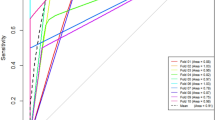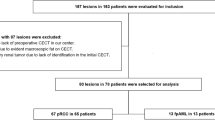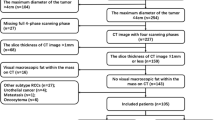Abstract
Purpose
This study aimed to discriminate fat-poor angiomyolipoma (fp-AML) from clear cell renal cell carcinoma (ccRCC) by constructing radiomics-based logistic classifiers in comparison with conventional computed tomography (CT) analysis at three CT phases.
Materials and methods
Twenty-two fp-AML patients and 62 ccRCC patients who were pathologically identified were enrolled in this study, and underwent three-phase (unenhanced phase, UP; corticomedullary phase, CMP; nephrographic phase, NP) CT examinations. Whole-tumor regions of interest (ROIs) were contoured in ITK software by two radiologists. Radiomic features were dimensionally reduced by means of ANOVA + MW, correlation analysis, and LASSO. Four radiomics logistic classifiers including the UP group, CMP group, NP group, and sum group were built, and the radiomic scores (rad-scores) were calculated. After collecting the qualitative and quantitative conventional CT characteristics, the conventional CT analysis logistic classifier and the radiomics-based logistic classifier were constructed. The receiver operating characteristic curve (ROC) was constructed to evaluate the validity of each classifier.
Results
The area under curve (AUC) of the conventional CT analysis logistic classifier including angular interface, cyst degeneration, and pseudocapsule was 0.935 (95% CI 0.860–0.977). Regarding logistic classifiers for radiomics analysis, the AUCs of the UP group were 0.950 (95% CI 0.895–1.000) and 0.917 (95% CI 0.801–1.000) in the training set and testing set, respectively, which were higher than those of the CMP and NP groups. The AUCs of the sum group were observed to be the highest. The top three selected features for the UP and sum groups belonged to GLCM parameters and histogram parameters. The radiomics-based logistic classifier encompassed cyst degeneration, pseudocapsule, and sum rad-score, and the AUC of the model was 0.988 (95% CI 0.935–1.000).
Conclusion
Whole-tumor radiomics-based CT analysis is superior to conventional CT analysis in the differentiation of fp-AML from ccRCC. Cyst degeneration, pseudocapsule, and sum rad-score are the most significant factors. The radiomics analysis of the UP group shows a higher AUC than that of the CMP and NP groups.





Similar content being viewed by others
References
Jinzaki M, Silverman S G, Akita H, et al., Renal angiomyolipoma: a radiological classification and update on recent developments in diagnosis and management[J]. Abdominal Imaging, 2014, 39(3):588-604.
Taryn H, Mcinnes M D F, Nicola S, et al., Can Quantitative CT Texture Analysis be Used to Differentiate Fat-poor Renal Angiomyolipoma from Renal Cell Carcinoma on Unenhanced CT Images?[J]. Radiology, 2015, 276(3):787-96.
Park B K, Renal Angiomyolipoma: Radiologic Classification and Imaging Features According to the Amount of Fat[J]. AJR Am J Roentgenol, 2017, 209(4):1-10.
Wasser E J, Shyn P B, Riveros-Angel M, et al., Renal cell carcinoma containing abundant non-calcified fat[J]. Abdominal Imaging, 2013, 38(3):598-602.
Kim R, Lee J M, Joo I, et al., Differentiation of lipid poor angiomyolipoma from hepatocellular carcinoma on gadoxetic acid-enhanced liver MR imaging[J]. Abdominal Imaging, 2015, 40(3):531-41.
Sureka B,Khera P S, Radiologic Classification and Imaging Features of Renal Angiomyolipomas According to the Amount of Fat[J]. Ajr American Journal of Roentgenology, 2018, 210(3):W136-W136.
Lee H, Hong H, Kim J, et al., Deep Feature Classification of Angiomyolipoma without Visible Fat and Renal Cell Carcinoma in Abdominal Contrast‐Enhanced CT Images with Texture Image Patches and Hand‐Crafted Feature Concatenation[J]. Medical Physics, 2018, 45(4):1550-1561.
Yan L, Liu Z, Wang G, et al., Angiomyolipoma with minimal fat: differentiation from clear cell renal cell carcinoma and papillary renal cell carcinoma by texture analysis on CT images[J]. Academic Radiology, 2015, 22(9):1115-1121.
Ishigami K, Pakalniskis M G, Leite L V, et al., Characterization of renal cell carcinoma, oncocytoma, and lipid-poor angiomyolipoma by unenhanced, nephrographic, and delayed phase contrast-enhanced computed tomography[J]. Clin Imaging, 2015, 39(1):76-84.
Kim S H, Kim C S, Kim M J, et al., Differentiation of Clear Cell Renal Cell Carcinoma From Other Subtypes and Fat-Poor Angiomyolipoma by Use of Quantitative Enhancement Measurement During Three-Phase MDCT[J]. Ajr American Journal of Roentgenology, 2015, 206(1):W21.
Takahashi N, Leng S, Kitajima K, et al., Small (< 4 cm) Renal Masses: Differentiation of Angiomyolipoma Without Visible Fat From Renal Cell Carcinoma Using Unenhanced and Contrast-Enhanced CT[J]. Ajr American Journal of Roentgenology, 2015, 205(6):1194-202.
Li H, Li A, Hui Z, et al., Whole-Tumor Quantitative Apparent Diffusion Coefficient Histogram and Texture Analysis to Differentiation of Minimal Fat Angiomyolipoma from Clear Cell Renal Cell Carcinoma[J]. Academic Radiology, 2018, S1076633218303295-.
Feng Z, Rong P, Cao P, et al., Machine learning-based quantitative texture analysis of CT images of small renal masses: Differentiation of angiomyolipoma without visible fat from renal cell carcinoma[J]. Eur Radiol, 2018, 28(4):1625-1633.
Sasiwimonphan K, Takahashi N, Leibovich B C, et al., Small (< 4 cm) renal mass: differentiation of angiomyolipoma without visible fat from renal cell carcinoma utilizing MR imaging[J]. Radiology, 2012, 263(1):160.
Farber N J, Wu Y, Zou L, et al., Challenges in RCC Imaging: Renal Insufficiency, Post-Operative Surveillance, and the Role of Radiomics[J]. Kidney Cancer Journal Official Journal of the Kidney Cancer Association, 2015, 13(4):84.
Yamashita Y, Honda S, Nishiharu T, et al., Detection of pseudocapsule of renal cell carcinoma with MR imaging and CT[J]. AJR Am J Roentgenol, 1996, 166(5):1151-1155.
Shu J, Tang Y, Cui J, et al., Clear cell renal cell carcinoma: CT-based radiomics features for the prediction of Fuhrman Grade[J]. European Journal of Radiology, 2018, 109).
Li Z C, Zhai G, Zhang J, et al., Differentiation of clear cell and non-clear cell renal cell carcinomas by all-relevant radiomics features from multiphase CT: a VHL mutation perspective[J]. Eur Radiol, 2018.
Delgado A F, Fahlström M, Nilsson M, et al., Diffusion Kurtosis Imaging of Gliomas Grades II and III - A Study of Perilesional Tumor Infiltration, Tumor Grades and Subtypes at Clinical Presentation[J]. Radiology & Oncology, 2017, 51(2):121-129.
Hotker A M, Yousef M, Andreas W, et al., Use of DWI in the Differentiation of Renal Cortical Tumors[J]. Ajr American Journal of Roentgenology, 2016, 206(1):100.
Author information
Authors and Affiliations
Corresponding author
Ethics declarations
Conflict of interest
The authors declare that they have no conflict of interest.
Additional information
Publisher's Note
Springer Nature remains neutral with regard to jurisdictional claims in published maps and institutional affiliations.
Rights and permissions
About this article
Cite this article
Ma, Y., Cao, F., Xu, X. et al. Can whole-tumor radiomics-based CT analysis better differentiate fat-poor angiomyolipoma from clear cell renal cell caricinoma: compared with conventional CT analysis?. Abdom Radiol 45, 2500–2507 (2020). https://doi.org/10.1007/s00261-020-02414-9
Published:
Issue Date:
DOI: https://doi.org/10.1007/s00261-020-02414-9




